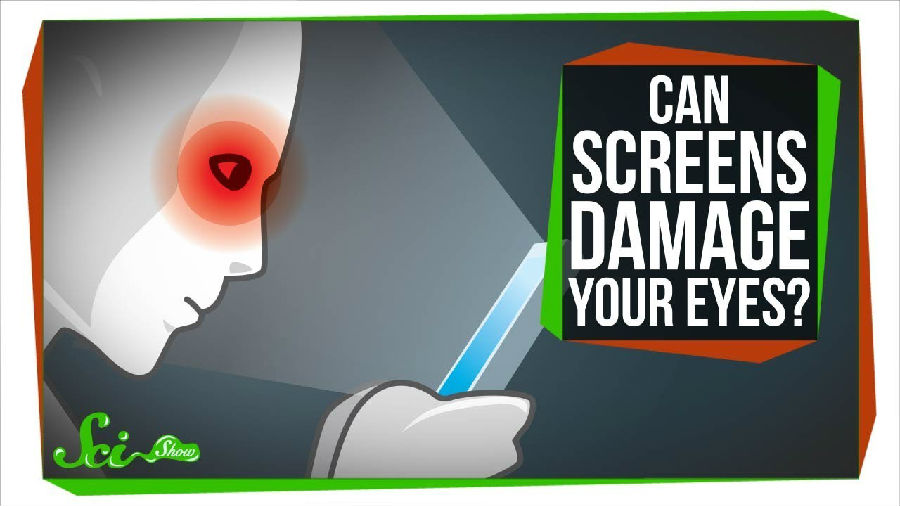If you're watching this video, you probably spend a lot of time around digital screens. Like right now, for example.
如果你正在观看本期视频,那么你一定是长时间盯着数码显示屏的吧。比如像现在这样。
And unless you're watching this far in the future after we've had some sort of apocalypse, there are screens all around us.
除非你是在人类经历某种天启后才看这个视频,否则我们几乎被屏幕所包围。
So of course, a lot of people are worried that exposure to all this unnatural light is harmful.
当然,很多人担心暴露于这种非自然光线对人类有害。
But can digital screens really hurt you? Well, at the very least, they can can cause temporary annoyances like headaches.
但是数码显示屏真的会伤害到我们么?至少它们会引起一些暂时性的困扰,比如头痛。
But the research is still out on permanent damage.
但是对齐永久伤害还在进行中。
If you stared at a screen for too long, you may find yourself feeling what's known as digital eye strain, or computer vision syndrome.
如果你盯着屏幕太久,你可能会发现自己会出现数字视觉疲劳或是计算机视觉综合症。
The most common symptoms are blurred vision, headache, and pain in the neck and shoulders.
最普遍的症状是视力模糊、头痛、脖子和肩膀疼。
Unfortunately, even though we know it's connected to spending a bunch of time looking at a screen, there are a bunch of potential causes —
不幸的是,虽然我们知道这些和长时间盯着电脑有关,但还有一堆潜在起因—
from screen viewing making you blink less often and squint more, to it affecting your pupil response time, to it exposing you to more blue light.
比如盯着屏幕让你眨眼频率更少、眯眼次数更多;会对你的瞳孔反应时间有影响,以及将你暴露于更多蓝光之中。
Or people could be suffering from digital eye strain because they don't have the right lens prescription, or one that doesn't take into account astigmatism.
或许人们会患上数字视觉疲劳是因为他们眼镜度数不对,或是没有考虑到散光问题。
Basically, there's no one cause. Luckily, the symptoms of digital eye strain go away when you give your eyes a proper rest,
大体上,这些问题不是由于某一个因素导致的。幸运的是,让眼睛休息适当休息,数字视觉疲劳的症状就会消失
and studies haven't shown any long-term effects even if you suffer from it regularly.
并且研究并未表明会有任何长期影响,即使你经常视觉疲劳。
And if you want to avoid that pain in the first place, doctors recommend you take a 20 second break from your screen every 20 minutes,
如果你想避免这种痛苦,医生建议每看屏幕20分钟就要休息20秒,
staring off at an object 20 feet away. Still, there might be another way screens could harm you,
凝视20英尺以外的事物。或许屏幕还会以另一种方式伤害你,
and that's through exposure to blue light that can kill cells in your eyes.
即通过暴露于蓝光之中,让蓝光杀死你眼睛中的细胞。
The color of blue light comes from its short wavelength,
蓝光的颜色来自于短波长,
which also means it has high energy — enough that blue light can damage and eventually kill the cells in your eye's retina.
这也意味着它拥有着很高的能量——足以让蓝光伤害或最终杀死人眼视网膜中的细胞。

The light reacts with certain molecules, knocking off bits of them and creating reactive oxygen species, or ROSes,
光和某些分子产生反应,减少这种分子并创造出活性氧(ROSes),
which will bond with almost anything.
它们几乎会和所有物质粘合。
They can cause so much damage that cells eventually destroy themselves in a process called apoptosis.
它们可以造成很多伤害,细胞最终在细胞凋亡过程中自我毁灭。
We know this happens because researchers have done a lot of experiments —
我们之所以知道这一点是因为研究人员做过很多试验—
not directly on human eyes, of course, but on animal models like rats or human retinal cells grown in petri dishes.
当然不是直接用人眼进行实验,而是对动物模型,比如老鼠或是培养皿中培育的视网膜神经细胞。
The thing is, most of those studies focus on high-intensity light from LED lamps,
关键是其中多数研究都是关注于源自LED灯的高强度光,
and sometimes expose the subjects to that light for day-long lengths of time.
有时会让被试者一整天暴露于灯光下。
So even though we know that high intensity blue light definitely causes retinal cell death,
因此即使我们知道高强度蓝光一定会造成视网膜细胞死亡,
it doesn't tell us much about the real-life dangers of screens.
但这也不能说明屏幕的现实危险。
There was one 2017 study that looked at the effects of low intensity blue light at three different wavelengths emitted from common types of screens.
2017年的一项研究对普通屏幕发出的三种不同波长的低强度蓝光的影响进行观察。
Specifically, they found that blue light at 449 nanometers caused the largest increase in those harmful ROSes.
他们发现449毫微米的蓝光会导致有害活性氧的最大幅增长。
But light with a slightly longer wavelength of 470 nanometers didn't do much damage.
但是470毫微米的波长并不会造成多少伤害。
That 21-nanometer change in wavelength might not seem like a lot, but the difference means the two colors of light have different amounts of energy.
波长21毫微米的改变似乎并不多,但其中差距意味着两种颜色的光所拥有的能量总量的区别。
The 470 nanometer light, which was a sort of turquoise, just didn't have enough energy to effectively break apart molecules.
470毫微米的光,是一种蓝绿色,这种光的能量不足以分解分子。
This suggests we'd do well to decrease the amount of shorter wavelength blue light from our screens if we want to save our eyeballs.
这表明如果我们想拯救我们的眼球,我们最好减少屏幕短波长蓝光的数量。
But don't shut your eyes just yet, because it ignores one major comparison: daylight.
不要马上闭眼哦,因为这忽视了另一个主要对照物:日光。
Look anywhere on a clear day and you'll see a lot of blue.
天气晴朗的日子里,目光所到之处皆会看到蓝光。
And that blue light is way more intense than what you get from staring at a computer screen.
那种蓝光比电脑屏幕的蓝光更加强烈。
A paper published in 2016 looked at the amount of light — both in general and in the blue part of the spectrum —
2016年发表的一篇论文对光的数量进行观察—光谱普遍部分和蓝光部分—
from a range of electronic screens and compared it against the amount of blue light you'd be exposed to from simple daylight.
这些光来自电子屏幕,并将其与人类日常接触到的日常日光中的蓝光总量进行比较。
Its conclusion? The blue light from devices like laptops and smartphones, quote, does "not represent a biohazard, even for long-term viewing."
结果呢?电脑和手机发出的蓝光,“并不能代表一种生物危害,即便是长期观看。”
So go ahead and watch as many more SciShow videos as you want. We're officially non-hazardous!
所以去吧,《科学秀》想看多久看多久。我们可是毫无危害的!
And in the meantime, thanks for watching this episode of SciShow,
同时,感谢观看本期《科学秀》,
and thanks especially to our community on Patreon for making this show possible.
特别感谢Patreon的社区群体让《科学秀》成为可能。
We have a whole team working to bring you amazing facts and answer fascinating questions every day of the week,
我们整个团队每周都致力于为大家讲述令人吃惊的真相以及回答那些让人着迷的问题,
and we wouldn't be able to do any of this without your support.
没有大家的支持,我们走不到这一步。
And if you're not yet a patron and interested becoming one, just check out patreon.com/scishow to learn more.
如果你还不是我们的赞助人并且感兴趣的话,请登录
patreon.
com/
scishow了解更多。


